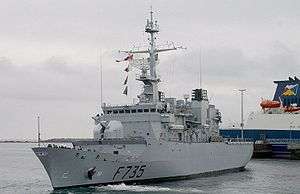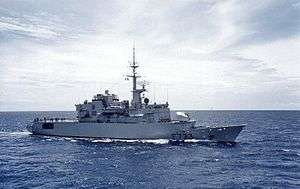Floréal-class frigate
 Frigate Vendémiaire of the French Navy | |
| Class overview | |
|---|---|
| Name: | Floréal class |
| Builders: | Chantiers de l'Atlantique, Saint-Nazaire |
| Operators: | |
| Preceded by: | D'Estienne d'Orves class |
| In commission: | 27 May 1992 |
| Completed: |
|
| Active: | |
| General characteristics | |
| Type: | Frigate |
| Displacement: |
|
| Length: | 93.5 m (307 ft) |
| Beam: | 14 m (46 ft) |
| Draught: | 4.3 m (14 ft) |
| Propulsion: |
|
| Speed: | 20 kn (37 km/h; 23 mph) |
| Range: | 10,000 nmi (19,000 km; 12,000 mi) at 15 kn (28 km/h; 17 mph), 13,000 nmi (24,000 km; 15,000 mi) at 12 kn (22 km/h; 14 mph) |
| Complement: |
|
| Sensors and processing systems: |
|
| Electronic warfare & decoys: |
|
| Armament: |
|
| Aircraft carried: | 1 × Panther anti-submarine helicopter |
The Floréal class is a type of light "surveillance frigates" designed for the needs of the French Navy after the end of the Cold War, ordered in 1989. They use construction standards of commercial ships. The ships are named after months of the Republican Calendar.
Definition of the requirements
After the end of the Cold War, it was felt that the risks of a large-scale military confrontation had all but disappeared. The Marine Nationale had to face new missions, while its escort avisos from the 1980s were ageing, and also badly adapted to low-risk zones.
The concept of "sentry frigate" emerged from the desire of the French government to protect its Exclusive Economic Zone (12 million km²), as defined in the Montego Bay treaties. Another need was to address matters of humanitarian aid, diplomacy, or naval law enforcement. To address these missions, an onboard helicopter is clearly the optimal solution, providing versatile, swift and long-range capabilities to deliver support, ferry or rescue.
These constraints defined the need for a ship which would be small; extremely stable to allow use of a heavy helicopter in all weather; small crew, while retaining capacities to accommodate navy commandos; light armament; economic and long-range propulsion system.
In keeping with the requirements, all the ships save one are based overseas in French territories. Prairial is based at Papeete, Tahiti; Floréal and Nivôse at La Reunion; Vendémiare at Noumea; Ventôse at Fort de France, Martinique, French Antilles. Germinal is based at Toulon, France.
Construction
The ships were built by Chantiers de l'Atlantique in Saint Nazaire. They were built using civilian construction methods as a cost saving measure; the rules of the classification society Det Norske Veritas were used for energy production and safety. Each ship was assembled from six pre-fabricated parts weighing up to 570 tonnes, joined by welding in a dry dock. This method was also used for the later La Fayette class. The first trials at sea were carried out in 1991 with an entirely civilian crew; the French Navy was only present as an observer.
Equipment
The armament was ordered from DCN Lorient, a traditional naval provider for the French Navy. The Floréal class, though designed to operate in low-risk areas, carry their own armament (they are not dependent on their helicopter).
The most visible piece of armament is the standard 100 mm multipurpose gun turret, a feature of most modern French warships. It is installed in one block, along with the magazine shelter and the targeting computer. All Floréal frigates are fitted with two Exocet missile launchers, a Dagaie decoy launcher system, two 20 mm Mod F2 cannon, as well as a complete range of detection and counter-measure electronics.
The unarmed helicopter is a naval Eurocopter Panther.
Royal Moroccan Navy
The Royal Moroccan Navy operates two Floréal-class frigates. The two frigates are named after the late Kings Mohammed V and Hassan II. They are accompanied by a total of 3 Panther helicopters.
Also, the frigares are armed with Oto Melara 76 mm instead of the French 100 mm naval guns with which French units are commonly armed.
Variant
STX France revealed a modernized variant of the Floréal class that it is offering to the Philippine Navy.[1][2]
See also
Gallery
 Frigate Germinal at Cherbourg
Frigate Germinal at Cherbourg Frigate Floréal, stationed at Bora-Bora lagoon
Frigate Floréal, stationed at Bora-Bora lagoon The frigate Prairial leaving Papeete for a long mission in South America
The frigate Prairial leaving Papeete for a long mission in South America Frigate Ventôse
Frigate Ventôse- Moroccan Navy Mohammed V
 Frigate Vendémiaire alongside at Nouméa
Frigate Vendémiaire alongside at Nouméa
References
- ↑ "STX France lève le voile sur Defendseas". meretmarine (in French). 30 October 2014. Retrieved 25 April 2015. (subscription required)
- ↑ "STX France se relance dans le militaire". meretmarine (in French). 27 October 2014. Retrieved 25 April 2015. (subscription required)
